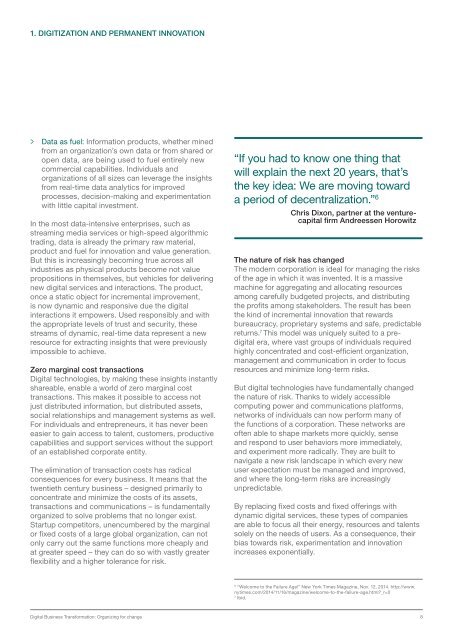ORGANIZING FOR CHANGE
UhUqd
UhUqd
Create successful ePaper yourself
Turn your PDF publications into a flip-book with our unique Google optimized e-Paper software.
1. DIGITIZATION AND PERMANENT INNOVATION<br />
> Data as fuel: Information products, whether mined<br />
from an organization’s own data or from shared or<br />
open data, are being used to fuel entirely new<br />
commercial capabilities. Individuals and<br />
organizations of all sizes can leverage the insights<br />
from real-time data analytics for improved<br />
processes, decision-making and experimentation<br />
with little capital investment.<br />
In the most data-intensive enterprises, such as<br />
streaming media services or high-speed algorithmic<br />
trading, data is already the primary raw material,<br />
product and fuel for innovation and value generation.<br />
But this is increasingly becoming true across all<br />
industries as physical products become not value<br />
propositions in themselves, but vehicles for delivering<br />
new digital services and interactions. The product,<br />
once a static object for incremental improvement,<br />
is now dynamic and responsive due the digital<br />
interactions it empowers. Used responsibly and with<br />
the appropriate levels of trust and security, these<br />
streams of dynamic, real-time data represent a new<br />
resource for extracting insights that were previously<br />
impossible to achieve.<br />
Zero marginal cost transactions<br />
Digital technologies, by making these insights instantly<br />
shareable, enable a world of zero marginal cost<br />
transactions. This makes it possible to access not<br />
just distributed information, but distributed assets,<br />
social relationships and management systems as well.<br />
For individuals and entrepreneurs, it has never been<br />
easier to gain access to talent, customers, productive<br />
capabilities and support services without the support<br />
of an established corporate entity.<br />
The elimination of transaction costs has radical<br />
consequences for every business. It means that the<br />
twentieth century business – designed primarily to<br />
concentrate and minimize the costs of its assets,<br />
transactions and communications – is fundamentally<br />
organized to solve problems that no longer exist.<br />
Startup competitors, unencumbered by the marginal<br />
or fixed costs of a large global organization, can not<br />
only carry out the same functions more cheaply and<br />
at greater speed – they can do so with vastly greater<br />
flexibility and a higher tolerance for risk.<br />
“If you had to know one thing that<br />
will explain the next 20 years, that’s<br />
the key idea: We are moving toward<br />
a period of decentralization.” 6<br />
Chris Dixon, partner at the venturecapital<br />
firm Andreessen Horowitz<br />
The nature of risk has changed<br />
The modern corporation is ideal for managing the risks<br />
of the age in which it was invented. It is a massive<br />
machine for aggregating and allocating resources<br />
among carefully budgeted projects, and distributing<br />
the profits among stakeholders. The result has been<br />
the kind of incremental innovation that rewards<br />
bureaucracy, proprietary systems and safe, predictable<br />
returns. 7 This model was uniquely suited to a predigital<br />
era, where vast groups of individuals required<br />
highly concentrated and cost-efficient organization,<br />
management and communication in order to focus<br />
resources and minimize long-term risks.<br />
But digital technologies have fundamentally changed<br />
the nature of risk. Thanks to widely accessible<br />
computing power and communications platforms,<br />
networks of individuals can now perform many of<br />
the functions of a corporation. These networks are<br />
often able to shape markets more quickly, sense<br />
and respond to user behaviors more immediately,<br />
and experiment more radically. They are built to<br />
navigate a new risk landscape in which every new<br />
user expectation must be managed and improved,<br />
and where the long-term risks are increasingly<br />
unpredictable.<br />
By replacing fixed costs and fixed offerings with<br />
dynamic digital services, these types of companies<br />
are able to focus all their energy, resources and talents<br />
solely on the needs of users. As a consequence, their<br />
bias towards risk, experimentation and innovation<br />
increases exponentially.<br />
6<br />
“Welcome to the Failure Age!” New York Times Magazine, Nov. 12, 2014. http://www.<br />
nytimes.com/2014/11/16/magazine/welcome-to-the-failure-age.html?_r=0<br />
7<br />
Ibid.<br />
Digital Business Transformation: Organizing for change 8


